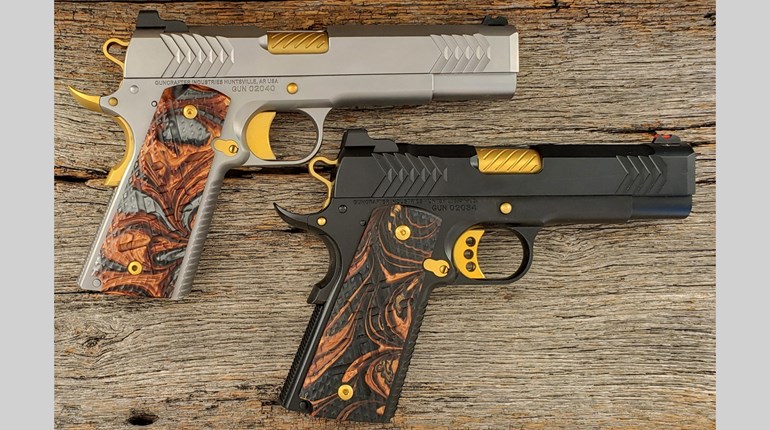
Note: While many of you may be wondering why I didn’t choose to install the trigger first, in addition to serving as a means of stopping a trigger’s travel choosing to install the magazine catch (AKA magazine release) first assures magazines drop freely once it’s properly fitting and installed. Conversely, fitting and installing the trigger first adds another part to the mix and the potential for magazines to bind on the trigger bow, thus complicating the fitting process unnecessarily.
Also, don’t forget to purchase a magazine-catch spring and a magazine-catch lock, because generally the three parts are not sold together and such an oversight can be quite frustrating, not to mention delay your build.
As it is, the three parts will work fine unaltered, however, with slight modification you can improve its range of motion and cause magazines to fall freely under their own weight once the magazine-release is depressed.
Begin by breaking out the jeweler’s files and magnifiers. Then, prep the magazine-catch lock by lightly beveling the leading edge of the “tab” of the magazine-catch lock. According to Drake Oldham, author of “The M1911 Complete Assembly Guide,” should the lock rotate, the bevel will “vector a component of the spring force into a counterclockwise rotation” thereby keeping the lock in its locked position.
Next, assemble the components by slipping the magazine-catch lock spring over the magazine-catch lock and insert both parts in the channel in the magazine catch, From there, using the appropriate screwdriver or wrench depress the spring and lock inside the channel until you can turn the tab counterclockwise, locking it inside the body of the magazine catch.
Before installing it in the frame, take a moment and insert an empty magazine in the frame to make sure it goes in and falls out without any resistance. If so, find the areas of binding/interference in the mag well and sand recheck them until the magazine falls out cleanly.
Now, install the magazine catch by dropping it into the right side of the frame and depressing it until it is slightly less than flush from the right side of the frame and rotate the lock screw clockwise until it snaps, securing it into place.
Chances are the magazine catch feels stiff during actuation, and that’s fine for the moment, providing it moves within its full range of motion without binding. Now, reinstall the empty magazine and tug it to make sure it won’t pop free without actuating the magazine catch. Depress it hard, because there’s no room for finesse in the heat of a gunfight. If it falls free, when the magazine catch is sharply depressed and held in place, mission accomplished.
More often, however, you’ll find the magazine won’t drop free. To discover the reason, remove the magazine, peer down inside the mag well with a flashlight while fully depressing the magazine catch. You should see the left side of the magazine-catch body protruding into the mag well despite the catch being fully depressed. According to Kuleck and Oldham, “This edge presses against the left side of the magazine even as the magazine retention `stud’ on the right side of the catch body has been disengaged from the notch in the right side of the magazine. The left side of the magazine-catch body can, if not properly fitted, drag on the magazine body at best and keep the magazine from not falling out at worst.”
The fix is a little time-consuming, but simple. Break out the files and move the radius on the left side of the magazine-catch body farther to the left until it doesn’t protrude into the magazine well when it’s installed and fully depressed. Start with a small, smooth, flat file (such as the barrel-lug file sold by Kart.) and lightly file the curved portion of the catch—which may have a slight casting seam—getting rid of said seam not only smoothes entry for the magazine, you begin to gain so clearance for the magazine when the catch is pressed inward.

Then transition to a round file to “move” the transition from the now seamless flat to the curved area farther to the left. (i.e., closer to the button on the magazine catch.) Take a few light swipes at a time. Then reinstall the catch, insert an empty magazine. Give it a tug to see if it’s lock in place. Now, fully depress the mag catch and see if the magazine falls free. Another indication you’re done is when depressing the mag catch eliminates any traces of the mag-catch body from protruding inside the magazine well. Lather, rinse and repeat, but be careful not to overdo it.
Once the magazine falls free, the final process involves lapping the magazine catch so it operates smoothly. Do so by removing the catch and apply a small amount of lapping compound to the part of the catch that engages the right side of the frame (the side with the lock screw.) Then, depress the magazine-catch button several times rapidly, until it’s silky-smooth.
While the process is simple, after a few dozen repetitions it can become uncomfortable. Thankfully, there’s a solution. Hold the frame using both hands and orient the magazine-catch button so it rests against the front corner of your workbench and press rapidly on the frame to cycle the mag catch through its travel. The end result is a smooth-operating mag catch and less wear and tear on your fingers.

In the next installment, I’ll discuss the proper way to fit a trigger.




































